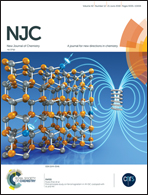Cu(ii) complexes of a tridentate N,N,O-donor Schiff base of pyridoxal: synthesis, X-ray structures, DNA-binding properties and catecholase activity†
Abstract
Two new Cu(II) complexes [Cu(L1)(N3)] (1) and [Cu(L1)(NCS)]n (2), where HL1 ((E)-4-((2(dimethylamino)ethylimino)methyl)-5-(hydroxymethyl)-2-methylpyridin-3-ol) is an N,N,O-donor Schiff base ligand, have been synthesized. These complexes were characterized on the basis of their spectroscopic, electrochemical, and other physicochemical properties. X-ray crystal structure determination reveals that in complex 1, Cu(II) is in a square planar geometry with the N,N,O-donor ligand and a terminally coordinated azide ion. In complex 2, however, Cu(II) has a square pyramidal geometry, and apart from the tridentate Schiff base ligand there is a thiocyanate ion, which acts in a μ1,3-bridging mode, connecting the adjacent Cu(II) atoms in an axial–equatorial fashion forming a one dimensional chain. Cyclic voltammetry shows that the complexes undergo Cu(II)/Cu(I) reductions at −0.40 to −0.55 V followed by imine reduction at around −0.7 V. Cu(I)/Cu(0) reduction is observed at approximately −0.9 V. Complex 1 also shows appreciable catalytic activity for the aerial oxidation of 3,5 DTBCH2 to DTBQ (catecholase activity). Both the complexes also show strong binding affinity towards calf-thymus DNA.



 Please wait while we load your content...
Please wait while we load your content...